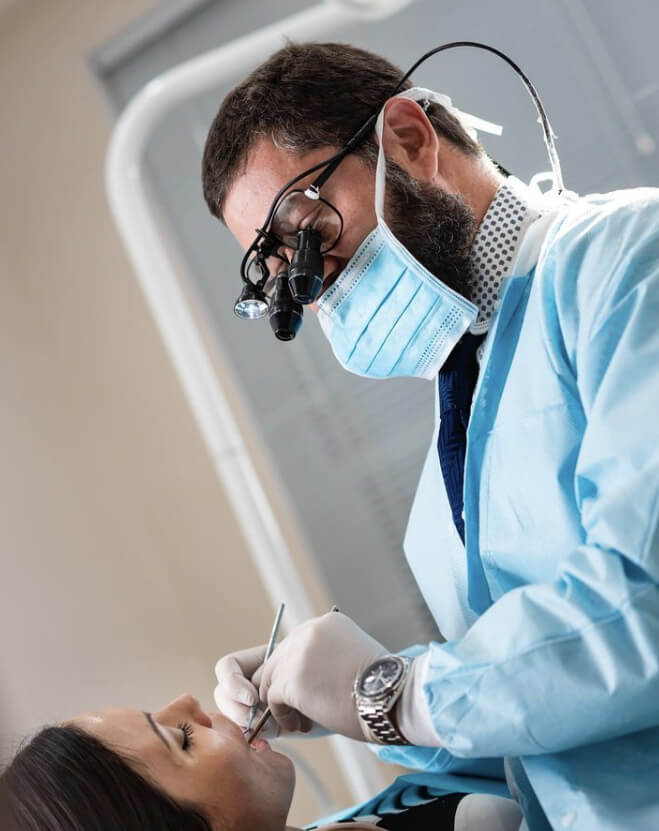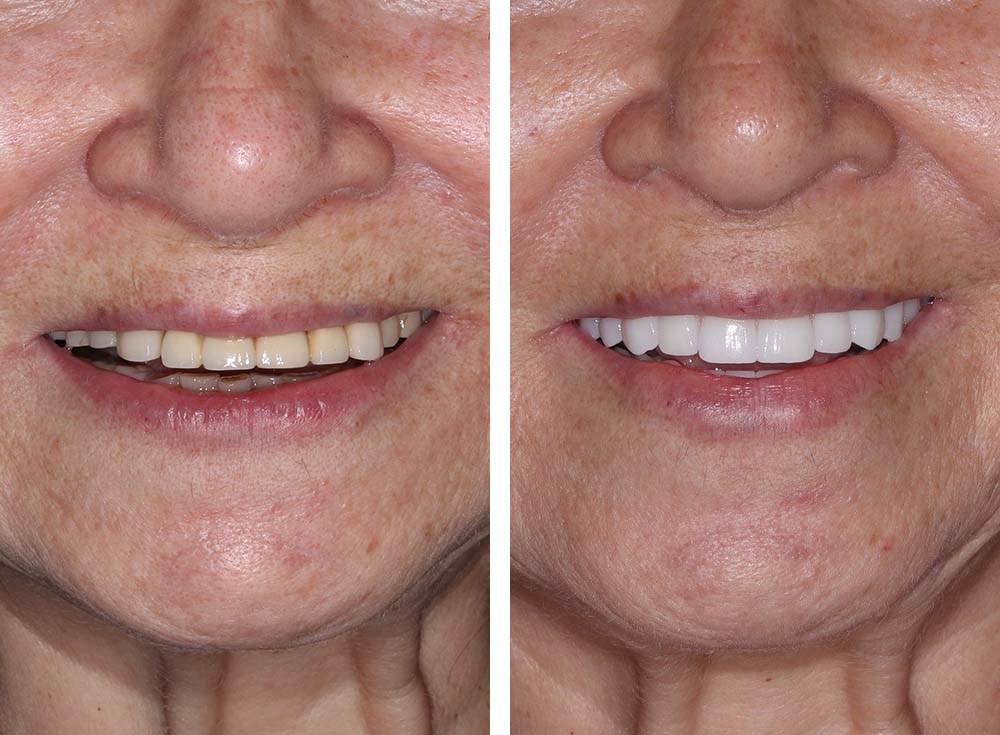Failed Dental Implant - Implant Rejection

Dental implant surgery is a highly predictable procedure, with a success rate as high as 97-99%. However, in 1-3% of cases, the implants may fail to integrate properly.
How can you recognize the symptoms of implant rejection?
Implant Rejection – What Is It?
Implant rejection refers to the loosening of the dental implant and the loss of its functionality. This occurs due to inflamed, infected soft tissue and bone surrounding the implant.
There are two types of dental implant failure:
Early implant failure – the implant failed to integrate during the osseointegration period (within the first 6 months after placement).
Delayed implant failure – the implant became loose after 7 or more months of being fully integrated with the bone tissue.
«A big role in the success of dental implant integration is played by the following two factors.
Firstly, the level of the doctor’s understanding of the nature of bone in different patients. The doctor needs a minimum of 7 years of regular practice to learn to distinguish between different bone tissue biotypes. Without deep knowledge of various biotypes of jawbone, there is no success in implant osseointegration.
Secondly, the ability to learn from one’s mistakes. The doctor must review their work after 7-10 years, identify the cause of implant failure, draw conclusions, and learn from those mistakes. A skilled doctor is not one who only sees their successful cases but one who analyzes their unsuccessful cases and constantly improves his approach.
At the beginning of my practice in New York, I invited my patients back 5-10 years after implant placement to assess the results of osseointegration. I learned from my mistakes and solidified my knowledge through successful cases.
Currently, 80% of my practice in New York and Miami involves redoing the work of other doctors. I am a surgical implantologist as well as a certified periodontist. When an implantologist makes mistakes, they refer the patient to a periodontist.
As a result, I have seen a significant number of unsuccessful cases, which has allowed me to accumulate invaluable experience. This is the secret behind the 99.7% success rate of the implants I have placed!»

“Modern dental implants are made of biocompatible pure Grade 4 titanium or zirconia dioxide. Therefore, their rejection is not related to the body’s immune reaction to a foreign body. Rejection refers to a disruption in the connection between the implant and the bone tissue.“
Normal Osseointegration of a Dental Implant
After the dental implant is screwed into the jawbone, the process of osseointegration begins. The growth of bone tissue into the implant body occurs in several stages:
New spongy bone tissue forms around the dental implant, enveloping it and penetrating its porous surface.
The newly formed spongy bone around the dental implant is replaced by dense lamellar bone. The implant becomes firmly fixed in the bone and can withstand increased chewing loads. It can be loaded with a permanent crown.
The dental implant becomes an integral part of the jawbone.
Symptoms of a Failed Dental Implant
Next, let’s compare several symptoms – they can be within or beyond the norm. If you notice worrying symptoms, it is best to seek medical attention. That way, you’ll have a better chance of saving your implant!
Severe throbbing pain
For the first 2-3 days after the procedure, it is normal for the patient to experience mild discomfort. The discomfort and pain should subside by the fourth day.
If you experience intensifying pain 7-10 days or more after the procedure, it's important to seek professional help. You could be at risk of implant rejection.
Gum swelling
After the surgical intervention, the gums may slightly swell for 2-3 days. By the fourth day, the swelling should subside.
Swollen and inflamed gums 7 days after the procedure are a sign of implant rejection due to infection.
High temperature
In the first few days after the dental implants are installed, a slight increase in body temperature can occur. This is a normal reaction.
However, if the temperature (38°C) persists for more than 4-5 days and is difficult to bring down, it's best to see a doctor.
Pus discharge
Not normal.
The appearance of pus discharge from under the gum at the site of implant installation is a sign of postoperative wound infection or rejection.
Noticing Symptoms of Implant Rejection?
Schedule an appointment with Dr. Tetri. After a comprehensive examination, the doctor will evaluate your clinical picture. If it is still possible to save the implants, conservative treatment will be provided.
Often, we redo the work of other doctors. We remove the loose implants, place in new ones, and put in a fresh set of teeth.

Example of Implant Replacement
A patient came to Dr. Tetri with complaints of constant pain while eating and brushing her teeth. The examination showed that the implants and bridges were installed incorrectly. The bone had atrophied significantly, and the implants had become loose.
What was done:
Dr. Tetri decided to perform a full mouth rehabilitation. The treatment took about a year. Dr. Tetri removed 4 implants from the lower jaw, performed bone grafting, and placed 5 implants in the lateral parts of the jaw. All upper teeth were removed because they were beyond repair. A sinus lift was performed, and 7 implants were placed with a full non-removable prosthesis made of ceramic crowns. A correct bite was restored.
Result:
The patient’s face appeared 10 years younger. She no longer had to endure pain while eating. The patient was happy and couldn’t stop admiring her new beautiful smile.
Reasons for Dental Implant Failure
Peri-implant pockets are formed, where pathogenic bacteria and food debris accumulate. Mucositis develops, followed by peri-implantitis.
Due to incorrect crown shape, the bite is over- or under-adjusted, causing constant overloading of the implant. Inflammation develops, increasing the risk of peri-implantitis.
Micro-gaps remain between the implant and abutment or abutment and crown, where food debris and pathogenic bacteria can settle.
Preventing Dental Implant Rejection
Compliance with postoperative recommendations
During the first few days after dental implant placement, it is important for the patient to strictly follow the doctor's recommendations, such as avoiding physical exertion and hot showers. Failure to follow these recommendations during the rehabilitation period often leads to implant failure.
Smoking cessation
Tobacco smoke contains substances that narrow blood vessels. Smoking during the first 4-6 weeks after dental implant placement increases the risk of rejection. The soft tissues around the implant will experience a deficiency of nutrients necessary for normal osseointegration. Suppression of salivary gland functions contributes to the active reproduction of pathogenic microflora in the mouth.
«Smoking after implant placement triples the risk of peri-implantitis. I strongly recommend quitting smoking at least 14 days before the surgery. Also, refrain from smoking for 21 days after implant surgery.»
Good oral hygiene
The accumulation of pathogenic bacteria around the dental implant leads to the infection of soft gum tissues - mucositis. In the absence of treatment, the inflammatory process leads to the destruction of soft tissues and spreads to the bone. Peri-implantitis develops, and bone tissue decreases, causing the implant to become loose.
«After dental implant placement, it is important to properly care for oral hygiene. In addition to daily home care, I recommend undergoing professional cleaning at the clinic every 3 months.»
How Do We Stay on Top of the Game?
The excellent training of our specialists and modern equipment allows us to perform very complex operations – full mouth reconstruction, implantation of all teeth in one day.
Learn more about our technologies and approach.
Oral Cavity Sanitation
Before implant installation, we always perform a professional teeth cleaning - Ultrasonic and AirFlow. We remove bacterial plaque and calculus from the teeth. If periodontal pockets are present, we perform scaling - deep cleaning.
«To minimize the risk of soft tissue infection around the implant, I conduct a comprehensive oral hygiene before its installation. The operation takes place in maximum sterile conditions.»
PIC Technology
We use a unique PIC technology. We fix the exact position of the installed dental implants. We scan soft tissues. In the Exocad program, we adapt the implants with a virtual model of new teeth to properly distribute the chewing load. We eliminate the risk of implant rejection due to overload. We manufacture new teeth in our dental laboratory with an accuracy of up to 5 microns.
«The PIC technology is the only one in the world that provides such accurate results. It eliminates the possibility of the slightest error. The chewing load is evenly distributed on the implants.»
Gum surgery
We perform gum plastic surgery after implantation. We recreate an aesthetic gum contour. We provide nourishment to the bone around the implant and protect the implantation area from infection. We eliminate the exposure of the implant neck and reduce the risk of peri-implantitis.
«As a board-certified periodontist, I know how important gum plastic surgery is for a favorable prognosis of implant treatment. I perform gum plastic surgery of any complexity. I use a dental microscope for jewelry precision. I apply platelet-enriched plasma and stem cells to reduce the rehabilitation period..»
Gneuromuscular dentistry
We perform full mouth rehabilitation according to GNM principles. We identify violations in the work of facial muscles, dysfunction of the TMJ. We eliminate the deep causes that lead to dental problems.

